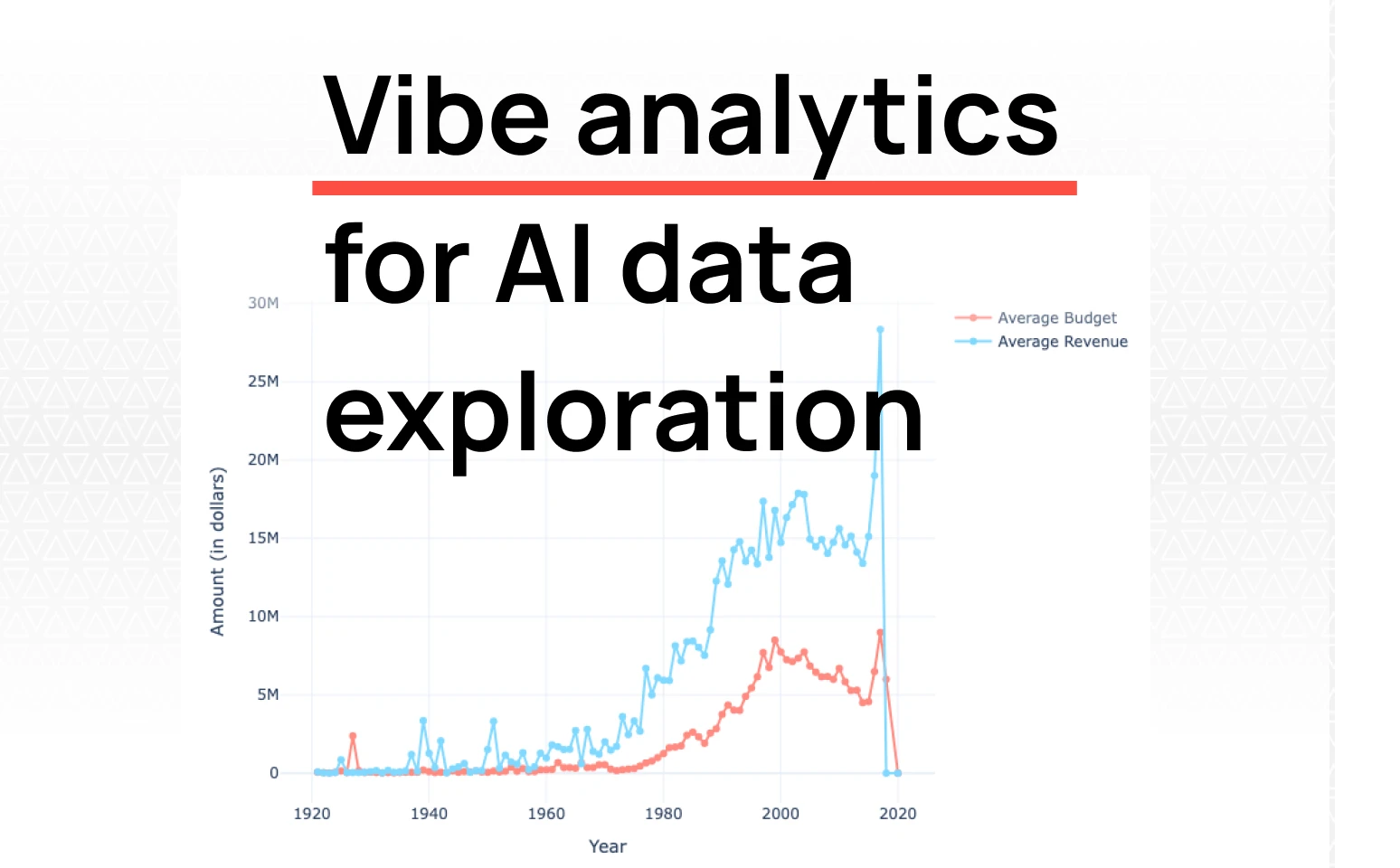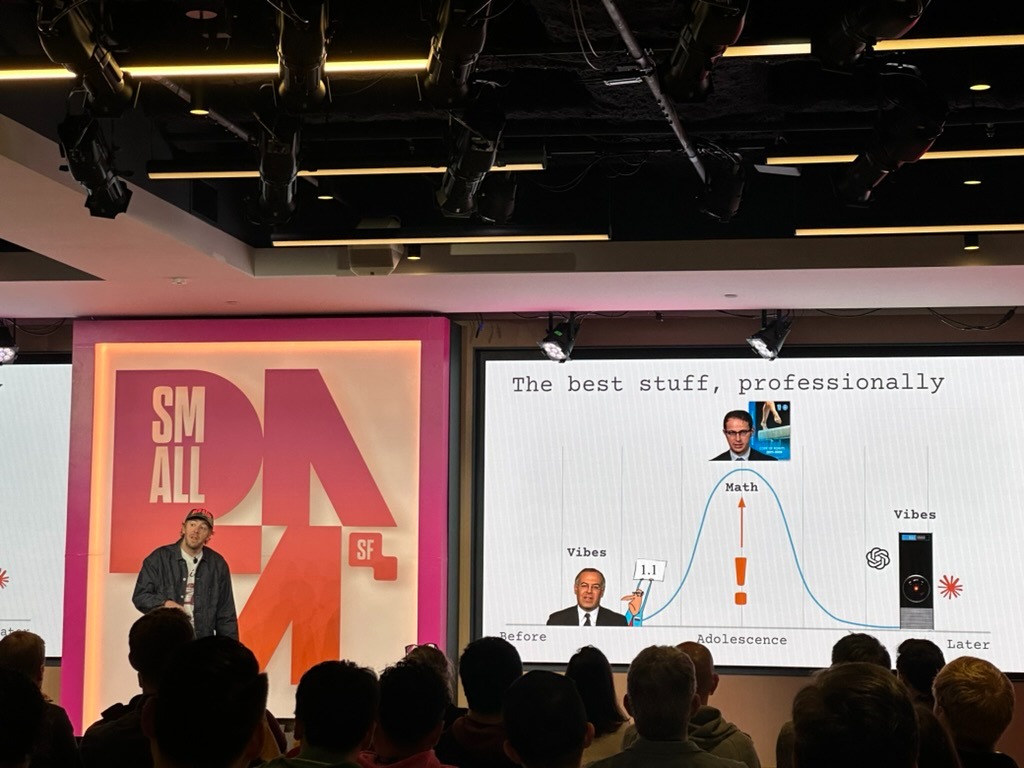
Vibe Analytics: A collaborative approach to AI data exploration
TL;DR: Benn Stancil's Small Data talk revealed that our definition of "best" analytics is shaped by formative years—current data practitioners grew up believing precise numbers equal better decisions, but a new "vibes" generation is emerging that embraces AI for directionally correct insights, saving precision for mission-critical metrics. This shift means data teams need to accept less control and focus on guardrails, business teams need to know when precision matters, and everyone needs more collaboration. At Fabi, we're seeing this play out: leaders now use AI for approximate answers to most questions, recognizing that what feels "right" to one generation isn't objectively right—it's experience-shaped, and the next generation will likely show us a better way.
This year the Fabi team attended MotherDuck's SmallData conference for the second time. After going to the inaugural conference last year, going back felt like a no-brainer. Most conferences nowadays are massive impersonal events where you're more likely to small talk with hundreds of people rather than have a few meaningful conversations. SmallData is different. If there were an objective way to measure the caliber and influence of attendees, the talent-to-person ratio would be through the roof.
And of course, at Fabi we're big believers in the small data movement and are fully embracing it. Sure, you can run your analysis in Fabi on billions of records, but embracing the small data movement to us is mostly about acknowledging that the actual data you analyze can be boiled down to a very small set. When handled properly, this approach can provide a 100X better experience versus trying to analyze big data with big data solutions. We attribute this mindset as a huge reason why a large cohort of our users describe Fabi as the most delightful and empowering data analysis platform experience they've ever had.
But in this post I actually want to talk about one specific topic at the conference that really left an impression on me. This came from Benn Stancil's talk – which in classic Benn style was informative, funny, and a touch cynical – about how what we think of as "the best" is informed by what we were exposed to in our formative years.
The premise of his talk is simple: Everyone thinks the best music is the music they grew up with in their teens. I enjoy "Mr. Brightside" by The Killers more than your average person not because it's an objectively amazing and catchy song, but more likely because I listened to it on repeat when my prefrontal cortex was developing. I doubt many teenagers today would jam as hard to that song as I did.
What does this have to do with analytics, AI, or SaaS in general? We all have formative years in our careers. Benn argues that the current generation of data practitioners grew up in the "Nate Silver" or "Moneyball" era, where we thought numbers and spreadsheets were cool. We built our entire worldview around the idea that more precise data equals better decisions. But what if the new generation doesn't think those are cool? What if the next generation is more of a "vibes" generation?
This concept stuck with me for two reasons:

Let's first talk about what's happening with the next generation of business leaders.
A note about the definition of "generation" here: When I'm talking about a new generation of business leaders, although there may be some correlation between age and generation, I'm not strictly talking about traditional generations. I'm talking more about generation in the sense of individuals working in businesses who are the first generation to truly embrace AI and experiment with it in all its messiness. Someone in their 20s is probably more likely to experiment and take risks, but there are plenty of examples of individuals further along in their careers who are participating in the hot messy stages of the AI Big Bang.
So what's happening with this generation?
Look at how Cluely raised $15 million almost entirely off of vibes (although we may need to redefine success and see how this pans out). Look at how YC just started accepting its first batch of companies that have openly stated they're fully vibe-coded. Look at how Aaron Levie from Box and Tobi Lütke from Shopify are pushing everyone to adopt AI agents to do the majority of the work.
What these all have in common is that they're operating a lot off of vibes. It's hard to explain really how Cluely exploded on the scene. Non-technical people can't really explain how their AI-powered apps work from soup to nuts in the same way that the average person driving a car today probably can't explain a fraction of the mechanics going on under the hood.
We can debate whether this is "right or wrong" all we want, but here's the reality: This new generation looks at AI and business differently, and soon enough they'll be looking at folks who don't embrace these "vibes" the same way the current generation looks at individuals who never moved past the fax machine.

One more point that was brought up in a few different talks was about the fact that AI is enabling better exploration of larger quantities of data, and this creates a certain error tolerance. One example that was provided by George Fraser, CEO of Fivetran was about analyzing survey results. In the past, to get a sense of what’s being talked about in survey responses, a team would sift through the responses, categorize them and then report the results back to the wider team. But in a world where George himself can simply talk to AI and explore these survey results on his own, he’s likely to get the exact same results as with the previous tedious process, or even better! Because in this new world he can draw his own conclusions about the survey and not hear the results filtered through a team that may have their own motives for presenting the results a certain way. This is powerful!
Alright, perhaps we agree on the premise here, but what does this mean for analytics? You can't possibly run a business purely off of vibes, right? You can't just approximate your numbers to make big strategic calls, can you?
I'd argue both yes and no. If I think about myself, I've always had an inclination to try and get the numbers as exact as they can possibly be (whatever that even means). The concepts of "vibes" and "numbers" seem contradictory. And yet, I find myself – as are more and more orgs, as we're seeing with the rapid adoption of Fabi – using AI to get approximately correct numbers for most of my needs.
Let's take a concrete example:
Number of weekly new users: If you ask a professional data scientist or analyst this question, they will take the time to find the number of users, ensure that duplicate users are removed, demo users removed, internal users removed, etc. But personally, when I'm reporting on these numbers now to get a sense of what's going on – if I'm just having a conversation with my team about this – I pull up Claude, which is hooked up to our Fabi MCP server, and ask our Analyst Agent the question. Our agent naturally handles a lot of the cases above, but does it handle all the cases based on the exact question I'm asking? Probably not. Does it matter? Definitely not.
Now does this approach work for all metrics? Also definitely not. If you're reporting on user activation and conversion rates, a difference of 0.5 percentage points can make a world of difference. The key is knowing when precision matters and when direction is enough.
We've touched on what vibe analytics means for the enterprise in a previous post, but here's my take on the larger implications:
Data teams need to be OK with less control: As a data team, you can try and retain full control of the data, or you can accept that there will be some degree of vibe analytics happening. Learning to embrace this and working with tools (like Fabi) that help set the right guardrails will not only help data teams focus on the more strategic problems, but also raise the overall data literacy across the organization, increasing the value of the data models that you create.
Business teams need to know their limits: Vibe analytics is all fine and good until someone gets hurt. This new paradigm works if there's a mutual understanding that the business and operations teams will know what level of precision they need based on the metrics they're pulling and the decisions they're trying to make.
Everyone needs to collaborate more: Unfortunately, today a lot of data teams operate more like support desks than strategic partners. Taking full advantage of this AI-first world requires collaboration between the data producers and consumers to understand what data is needed to answer questions, the expected level of fidelity, and where the limits are.
At the end of the day, at Fabi we're mostly sharing back lessons we learned from working with the most adventurous and pioneering data, product, and operations teams. We're likely to learn things in the next 18 months that we simply can't think about right now. Either way, it's good to take a step back and recognize that what might feel right or wrong to us isn't objectively right or wrong. It's molded by our experience of the world during our formative years, and a new generation is bound to make us question our sanity and perhaps ultimately show us that there is a better way.